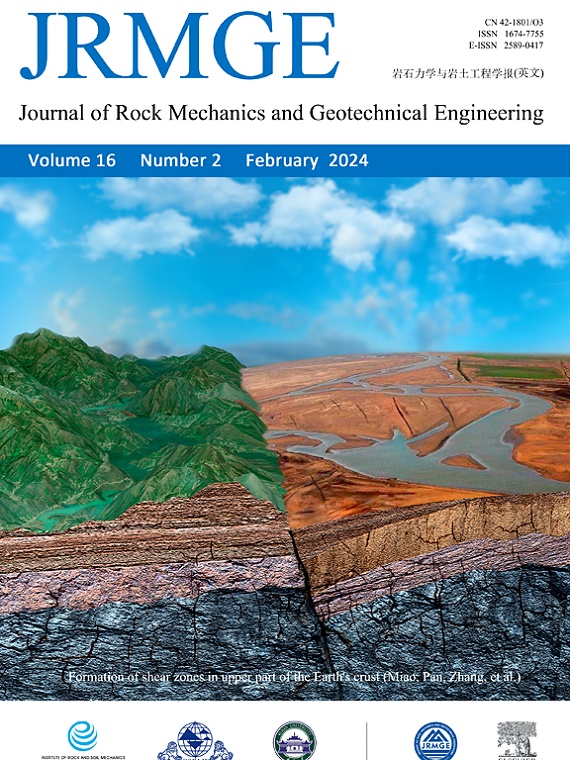求助PDF
{"title":"基于Hurst指数的缓动滑坡潜在滑动带识别方法","authors":"Haiqing Yang, Lili Qu, Lichuan Chen, Kanglei Song, Yong Yang, Zhenxing Liang","doi":"10.1016/j.jrmge.2023.08.007","DOIUrl":null,"url":null,"abstract":"The abrupt occurrence of the Zhongbao landslide is totally unexpected, resulting in the destruction of local infrastructure and river blockage. To review the deformation history of the Zhongbao landslide and prevent the threat of secondary disasters, the small baseline subsets (SBAS) technology is applied to process 59 synthetic aperture radar (SAR) images captured from Sentinel-1A satellite. Firstly, the time series deformation of the Zhongbao landslide along the radar line of sight (LOS) direction is calculated by SBAS technology. Then, the projection transformation is conducted to determine the slope displacement. Furthermore, the Hurst exponent of the surface deformation along the two directions is calculated to quantify the hidden deformation development trend and identify the unstable deformation areas. Given the suddenness of the Zhongbao landslide failure, the multi-temporal interferometric synthetic aperture radar (InSAR) technology is the ideal tool to obtain the surface deformation history without any monitoring equipment. The obtained deformation process indicates that the Zhongbao landslide is generally stable with slow creep deformation before failure. Moreover, the Hurst exponent distribution on the landslide surface in different time stages reveals more deformation evolution information of the Zhongbao landslide, with partially unstable areas detected before the failure. Two potential unstable areas after the Zhongbao landslide disaster are revealed by the Hurst exponent distribution and verified by the GNSS monitoring results and deformation mechanism discussion. The method combining SBAS-InSAR and Hurst exponent proposed in this study could help prevent and control secondary landslide disasters. ©2023 Institute of Rock and Soil Mechanics, Chinese Academy of Sciences. Production and hosting by Elsevier B.V. This is an open access article under the CC BY-NC-ND license (http://creativecommons.org/licenses/by-nc-nd/4.0/).","PeriodicalId":54219,"journal":{"name":"Journal of Rock Mechanics and Geotechnical Engineering","volume":"161 2","pages":"0"},"PeriodicalIF":9.4000,"publicationDate":"2023-11-01","publicationTypes":"Journal Article","fieldsOfStudy":null,"isOpenAccess":false,"openAccessPdf":"","citationCount":"0","resultStr":"{\"title\":\"Potential sliding zone recognition method for the slow-moving landslide based on the Hurst exponent\",\"authors\":\"Haiqing Yang, Lili Qu, Lichuan Chen, Kanglei Song, Yong Yang, Zhenxing Liang\",\"doi\":\"10.1016/j.jrmge.2023.08.007\",\"DOIUrl\":null,\"url\":null,\"abstract\":\"The abrupt occurrence of the Zhongbao landslide is totally unexpected, resulting in the destruction of local infrastructure and river blockage. To review the deformation history of the Zhongbao landslide and prevent the threat of secondary disasters, the small baseline subsets (SBAS) technology is applied to process 59 synthetic aperture radar (SAR) images captured from Sentinel-1A satellite. Firstly, the time series deformation of the Zhongbao landslide along the radar line of sight (LOS) direction is calculated by SBAS technology. Then, the projection transformation is conducted to determine the slope displacement. Furthermore, the Hurst exponent of the surface deformation along the two directions is calculated to quantify the hidden deformation development trend and identify the unstable deformation areas. Given the suddenness of the Zhongbao landslide failure, the multi-temporal interferometric synthetic aperture radar (InSAR) technology is the ideal tool to obtain the surface deformation history without any monitoring equipment. The obtained deformation process indicates that the Zhongbao landslide is generally stable with slow creep deformation before failure. Moreover, the Hurst exponent distribution on the landslide surface in different time stages reveals more deformation evolution information of the Zhongbao landslide, with partially unstable areas detected before the failure. Two potential unstable areas after the Zhongbao landslide disaster are revealed by the Hurst exponent distribution and verified by the GNSS monitoring results and deformation mechanism discussion. The method combining SBAS-InSAR and Hurst exponent proposed in this study could help prevent and control secondary landslide disasters. ©2023 Institute of Rock and Soil Mechanics, Chinese Academy of Sciences. Production and hosting by Elsevier B.V. This is an open access article under the CC BY-NC-ND license (http://creativecommons.org/licenses/by-nc-nd/4.0/).\",\"PeriodicalId\":54219,\"journal\":{\"name\":\"Journal of Rock Mechanics and Geotechnical Engineering\",\"volume\":\"161 2\",\"pages\":\"0\"},\"PeriodicalIF\":9.4000,\"publicationDate\":\"2023-11-01\",\"publicationTypes\":\"Journal Article\",\"fieldsOfStudy\":null,\"isOpenAccess\":false,\"openAccessPdf\":\"\",\"citationCount\":\"0\",\"resultStr\":null,\"platform\":\"Semanticscholar\",\"paperid\":null,\"PeriodicalName\":\"Journal of Rock Mechanics and Geotechnical Engineering\",\"FirstCategoryId\":\"1085\",\"ListUrlMain\":\"https://doi.org/10.1016/j.jrmge.2023.08.007\",\"RegionNum\":1,\"RegionCategory\":\"工程技术\",\"ArticlePicture\":[],\"TitleCN\":null,\"AbstractTextCN\":null,\"PMCID\":null,\"EPubDate\":\"\",\"PubModel\":\"\",\"JCR\":\"Q1\",\"JCRName\":\"ENGINEERING, GEOLOGICAL\",\"Score\":null,\"Total\":0}","platform":"Semanticscholar","paperid":null,"PeriodicalName":"Journal of Rock Mechanics and Geotechnical Engineering","FirstCategoryId":"1085","ListUrlMain":"https://doi.org/10.1016/j.jrmge.2023.08.007","RegionNum":1,"RegionCategory":"工程技术","ArticlePicture":[],"TitleCN":null,"AbstractTextCN":null,"PMCID":null,"EPubDate":"","PubModel":"","JCR":"Q1","JCRName":"ENGINEERING, GEOLOGICAL","Score":null,"Total":0}
引用次数: 0
引用
批量引用
Potential sliding zone recognition method for the slow-moving landslide based on the Hurst exponent
The abrupt occurrence of the Zhongbao landslide is totally unexpected, resulting in the destruction of local infrastructure and river blockage. To review the deformation history of the Zhongbao landslide and prevent the threat of secondary disasters, the small baseline subsets (SBAS) technology is applied to process 59 synthetic aperture radar (SAR) images captured from Sentinel-1A satellite. Firstly, the time series deformation of the Zhongbao landslide along the radar line of sight (LOS) direction is calculated by SBAS technology. Then, the projection transformation is conducted to determine the slope displacement. Furthermore, the Hurst exponent of the surface deformation along the two directions is calculated to quantify the hidden deformation development trend and identify the unstable deformation areas. Given the suddenness of the Zhongbao landslide failure, the multi-temporal interferometric synthetic aperture radar (InSAR) technology is the ideal tool to obtain the surface deformation history without any monitoring equipment. The obtained deformation process indicates that the Zhongbao landslide is generally stable with slow creep deformation before failure. Moreover, the Hurst exponent distribution on the landslide surface in different time stages reveals more deformation evolution information of the Zhongbao landslide, with partially unstable areas detected before the failure. Two potential unstable areas after the Zhongbao landslide disaster are revealed by the Hurst exponent distribution and verified by the GNSS monitoring results and deformation mechanism discussion. The method combining SBAS-InSAR and Hurst exponent proposed in this study could help prevent and control secondary landslide disasters. ©2023 Institute of Rock and Soil Mechanics, Chinese Academy of Sciences. Production and hosting by Elsevier B.V. This is an open access article under the CC BY-NC-ND license (http://creativecommons.org/licenses/by-nc-nd/4.0/).


